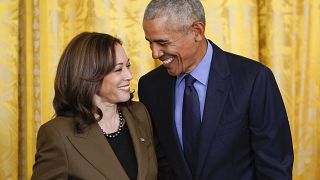USA
In major art museum collections in America, 85% of artists are white and only 1.2% are Black.
A new documentary, "Black Art: In the Absence of Light," aims to show that just because Black art may not hang in many galleries, it doesn't mean there haven't been Black artists creating prolific work.
"It's an opportunity to see the lineage of African-American artists in the 19th century, the 20th century and up to today, the 21st century. And I think the other thing that makes it vitally important, you see from these contemporary artists that we interviewed and shot in the film, people like Amy Sherald, Jordan Casteel and Theaster Gates and Kehinde Wiley," said filmaker Sam Pollard.
"We always were represented music, but not movies, not in the arts, so now it's an opportunity to see that. I mean, one of the things that's really interesting in this film is that little young girl looking up at Michelle Obama in the portrait that Amy Sherald created. That's phenomenal that she can see the First Lady of the United States, a Black woman, you know, who she can feel a certain level of esteem about and feel emboldened that she could one day be a First Lady of the United States. I mean, that's important."
The film begins with artist and art historian David Driskell and his 1976 show "Two Centuries of Black American Art."
His exhibition gave audiences an overview but thorough history of Black art in the United States since 1750. That exhibition in the Los Angeles County Museum of Art is often considered one of the most prolific moments in Black art history.
The film highlights a number of artists past and present, including Sherald and Kehinde Wiley, who painted President Obama's official portrait.
"A Black artist is going to be able to see those people, really see them, and not in a way the way that a white artist would. A white artist wouldn't see Michelle and Barack in the way they came in and Amy saw those people. That's why they were selected," said Pollard. "That's what Barack and Michelle understood, that in terms of representation, creating the representation of these two, they had to have a Black artist who understood who they were, who could see them, who could understand how to present them."
Pollard says the message he wants to get across in his film is fairly simple.
"Specifically this: that as great as some of these artists are that we learned about when I was a young man, there was a group of (Black) great artists that still existed around that same time," said Pollard. "And there's a group of great artists in the 21st century, African-American artists, that are definitely on the rise of being recognized. It's important."
"Black Art: In the Absence of Light" premiered Feb. 9.











02:18
Serena Williams narrates meteoric rise through the ranks of tennis in new docuseries
01:00
WATCH: Eco-Friendly Art and Graffiti Meet at Hong Kong's Art Fair
01:01
American artist and author Faith Ringgold dies at 93
02:20
The transformative power of makeup at the Professional Beauty Show London
02:18
London: art exhibit examines Black representation
Go to video
Bobi Wine’s documentary receives Oscar nomination, full list of nominees